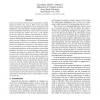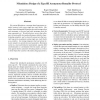134 search results - page 20 / 27 » Attack for Flash MIX |
ICSE
2009
IEEE-ACM
14 years 9 months ago
2009
IEEE-ACM
We present a new automated white box fuzzing technique and a tool, BuzzFuzz, that implements this technique. Unlike standard fuzzing techniques, which randomly change parts of the...
ACSAC
2004
IEEE
14 years 11 days ago
2004
IEEE
Large-scale attacks generated by fast-spreading or stealthy malicious mobile code, such as flash worms and e-mail viruses, demand new approaches to patch management and disinfecti...
ICC
2008
IEEE
14 years 3 months ago
2008
IEEE
Abstract—Under the emerging network coding paradigm, intermediate nodes in the network are allowed not only to store and forward packets but also to process and mix different dat...
SP
2003
IEEE
14 years 1 months ago
2003
IEEE
We present Mixminion, a message-based anonymous remailer protocol with secure single-use reply blocks. Mix nodes cannot distinguish Mixminion forward messages from reply messages,...
FC
2008
Springer
13 years 10 months ago
2008
Springer
At Oakland 2005, Murdoch and Danezis described an attack on the Tor anonymity service that recovers the nodes in a Tor circuit, but not the client. We observe that in a peer-to-pee...


